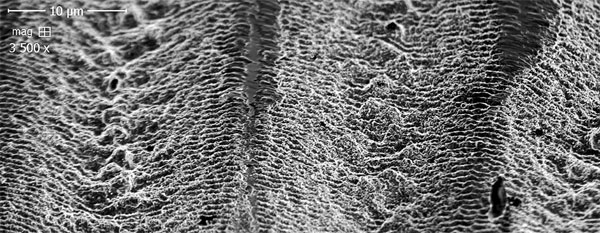
Laser Ablation Boosts GaAs Terahertz Emission
While there is still no cheap and efficient way to mass produce terahertz emitters, laser ablation can increase the output of GaAs, a common semiconductor used in these devices.
The surface microstructure of GaAs thin films plays an important role in energy absorption and emission, according to researchers in the Femtosecond Spectroscopy Unit at the Okinawa Institute of Science and Technology Graduate University (OIST).
Ablating the material with femtosecond laser pulses creates microscale grooves and ripples that increase its light absorption. After this process, GaAs terahertz output is enhanced by up to 65 percent if pumped by a sufficiently powerful laser.
"Femtosecond laser ablation allows us to engineer the properties of materials and to overcome their intrinsic limitations, leading, for example, to near 100 percent photon absorption, as well as broader absorption bandwidth, control of the electron concentration and lifetime," said postdoctoral researcher Julien Madéo.

Femtosecond laser ablation creates microscale grooves and ripples on the surface of a GaAs thin film. The scale bar is 10 μm; the magnification is 3500×. Courtesy of OIST.
The ablation technique increases output despite a decrease in photocurrent within the material. This counterintuitive phenomenon results from shorter charge-carrier lifetimes in ablated versus nonablated GaAs, the researchers said.
The terahertz region lies between IR light and microwaves on the electromagnetic spectrum, and includes wavelengths from 0.1 to 1 mm. Generation of terahertz waves is difficult because their frequency is too high for conventional radio transmitters and too low for optical emitters.
One of the most frequently used terahertz emitters is a photoconductive antenna, comprising two electric contacts and a thin film semiconductor, often GaAs, between them. When the antenna is exposed to a short pulse from a laser, the photons excite electrons in the semiconductor, and a short burst of terahertz radiation is produced. Thus the energy of the laser beam is transformed into a terahertz wave.
Terahertz radiation is absorbed by water, limiting the use of terahertz devices in the Earth's atmosphere to short distances. But it can penetrate fabrics, paper, cardboard, plastics, wood and ceramics. Many materials have a unique "fingerprint" in the terahertz band, allowing their easy identification with terahertz scanners.
Moreover, unlike x-rays and UV light, terahertz radiation is nonionizing, making it safe for use on live tissues and DNA. Terahertz waves could also be used in communications, where they would provide greater bandwidth than the microwaves used by WiFi networks today.
The research was published in Optics Letters (doi: 10.1364/OL.40.003388).
Published: September 2015